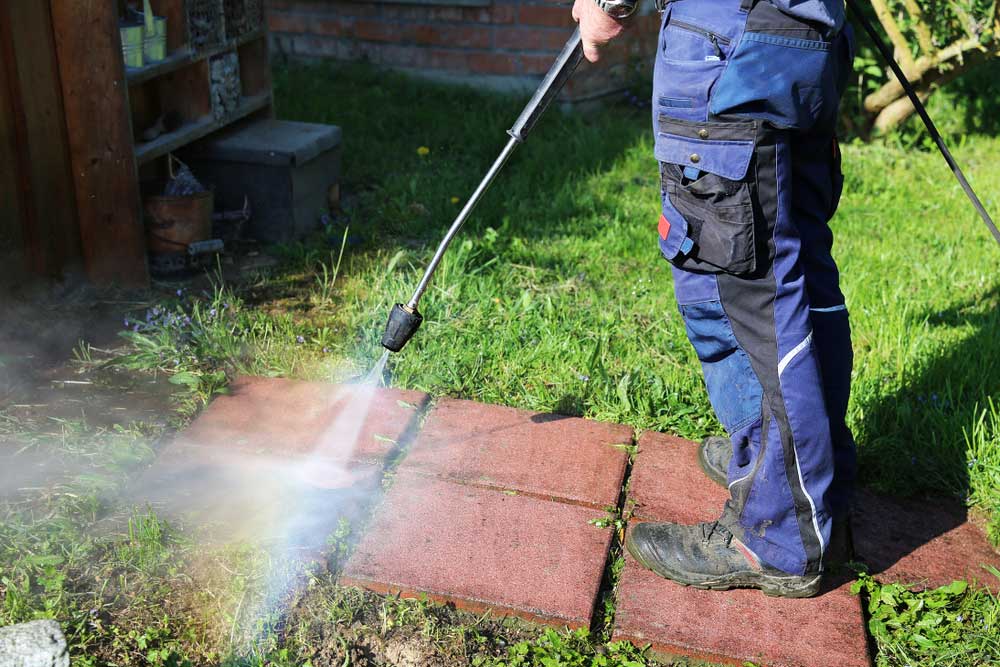Pressure washing your patio can be a daunting and intimidating task. But it doesn’t have to be! With the right supplies, knowledge, and attitude, you can have a spotless patio in no time – almost as if by magic!
This article will teach you how to pressure wash your patio quickly and easily using simple step-by-step instructions. We’ll walk you through gathering the necessary supplies, preparing the patio, connecting the pressure washer, applying detergent, and finally pressure washing your patio.
By following our guide closely you’ll soon have a brand new looking patio that will impress all of your friends and family.
Gather the Necessary Supplies
Gathering the appropriate supplies prior to pressure washing a patio can ensure an efficient and effective cleaning process.
It is important to consider the type of equipment that will be needed for the job, such as a gas or electric pressure washer, and whether it is more economical to purchase or rent one.
Additionally, protective gloves should be worn when handling any power equipment and various soaps or detergents should be selected according to the surface material being cleaned.
Safety glasses are also highly recommended as not only do they protect against flying debris but also from exposure to potentially hazardous chemicals.
Additionally, long-handled brushes can be useful for scrubbing hard-to-reach areas while various nozzles and sprayers can help create more targeted streams of water for different types of surfaces.
Finally, a bucket and stiff bristle brush should also be included in order to make sure all debris is removed before beginning the pressure washing process.
All these materials are essential in preparing for an effective cleaning experience with fewer risks involved.
Prepare the Patio
Prior to commencing the pressure washing process, it is essential to adequately prepare the patio surface. Firstly, it is important to check weather conditions. A windy day can result in a blowback of dirt and debris onto the siding of a house or other nearby objects that should not be sprayed with pressurized water. Additionally, one should assess any damage to the patio’s surface prior to beginning cleaning. Cracks in tiles or concrete require special attention; otherwise, hard stains may become more deeply embedded and difficult to remove during cleaning. Lastly, furniture should be removed from the area before starting and any plants should be covered or relocated for their protection from the pressurized spray.
| Weather | Damage | Furniture & Plants |
|:——-:|:——:|:——————:|
| Check | Assess | Remove/Protect |
Pressure washing requires adequate preparation in order for successful results with minimum effort. The information provided will help ensure that proper steps are taken prior to commencing this task so that a clean and long-lasting finish can be achieved with ease and satisfaction. Taking these simple precautions can prevent further problems down the line while providing an efficient solution that will have lasting impact on outdoor spaces for years to come.
Connect the Pressure Washer
Connecting the pressure washer correctly is essential to achieving a successful and safe cleaning experience. Before connecting, check the manufacturer’s instructions carefully to ensure all safety requirements are met, such as selecting the correct pressure gauge depending on the type of surface that needs to be cleaned.
Moreover, make sure all hoses are in good condition and not damaged or worn before they can be used for any pressure washing task. It is also important to note that it is necessary to connect the hose properly so that there will be no disconnections during operation.
The next step in connecting the pressure washer is securing a garden hose connection, which should always remain connected while operating a pressure washer. This connection ensures that water flow from your house’s main supply line has been established and provides stability when working with a powerful machine like this one. Additionally, you need to make sure that all connections between components have been securely fastened with clamps or screw-type fittings for extra reliability and security during use.
Linking up an appropriate outlet after selecting the correct power source is also critical for proper functioning of your equipment. Generally speaking, most electric models require either a standard 120V GFCI (Ground Fault Circuit Interrupter) outlet or 230V outlet with an appropriate circuit breaker depending on their wattage capacity; whereas gasoline powered units would require fuel lines linking it up with suitable tank connections.
Once these steps have been followed accordingly, you can now proceed to start pressurizing your patio surfaces safely without worry of damages due to improper installation.
Apply Detergent
Applying detergent to the surface before pressure washing allows for a more thorough and efficient cleaning process, akin to using a brush to scrub away dirt. When applying detergent, it is important to keep safety in mind.
Always wear appropriate protective gear while working with any kind of cleaning solution, such as gloves and goggles. It is also important to read all of the instructions from the manufacturer regarding how much detergent should be used for an optimal clean.
When selecting a cleaning solution there are many options available on the market today. For patio surfaces, it is best to choose one that is made specifically for outdoor use and will not damage surfaces like wood or concrete. Additionally, choose one that has been certified safe by an independent organization such as Green Seal or EcoLogo certifications which ensure that it contains no hazardous chemicals or ingredients that could harm plants or animals living in the area.
Once you have selected your cleaning solution and determined how much is needed for your project, apply it liberally but evenly across the patio surface with a garden sprayer or pump-up bottle applicator. Allow it to sit undisturbed for at least 15 minutes before beginning the pressure washing process so that it can effectively break down dirt and grime on contact.
This will help make sure you get a deeper clean when pressure washing your patio surfaces.
Pressure Wash the Patio
Pressuring washing your patio is an effective way of cleansing the surface and restoring a clean look.
To begin, start at the top of the patio and move in a consistent pattern across the entire area.
After completing this step it is important to rinse thoroughly before allowing any standing water to dry on the surface.
Start at the top
Beginning at the top of the patio is essential to ensure effective pressure washing. When starting from the top, it allows for any dirt and grime that is pushed by the pressure washer to fall away instead of being redeposited on a freshly cleaned area. This can be further enhanced by using a rotary attachment, which ensures an even distribution of water throughout the surface.
Additionally, starting at the top of the patio will help protect nearby plants or objects since only lower pressure is used for cleaning in this direction.
Furthermore, different types of pressure washers are designed for different areas and surfaces. In order to select an appropriate device for your patio, it’s important to consider factors such as size, power output and type of nozzle.
For example, electric powered models are suitable for smaller patios due to their limited capacity while petrol-powered ones offer greater power and flexibility when cleaning large areas with stubborn stains or dirt buildup. Taking into account these details when selecting a pressure washer will provide better results overall.
Move in a consistent pattern
Having started at the top, it is now time to move in a consistent pattern.
When pressure washing your patio, investing in quality equipment will ensure that the job is done correctly and efficiently.
The right kind of brush or nozzle attachment should be used based on the material of the patio surface.
In addition, it is important to use protective gear such as safety glasses and gloves in order to protect yourself from any dirt or debris that may get kicked up during the process.
With the right equipment and protective gear, you can easily pressure wash your patio quickly and safely.
Rinse thoroughly
Once the patio has been pressure washed, it is important to thoroughly rinse off any residue.
This should be done with a garden hose set to its lowest pressure setting and at a temperature that will not damage vulnerable plants or materials on the patio.
Care should also be taken when selecting the nozzle for this step, as some may produce too much water pressure and cause damage to the patio surface or surrounding items.
To ensure that every last bit of debris is removed from the areas being rinsed, moving in a consistent pattern across the entire area is essential.
Doing so will help guarantee that no spots are missed during this final step of power washing your patio.
Conclusion
The pressure washing process is completed and the patio should now be restored to its former glory.
It is essential to maintain the patio on a regular basis, as it will improve the longevity of the material and keep it looking great for years to come.
Despite this being a relatively straightforward task, it can be quite labour intensive and time consuming; however, with some simple steps following these instructions one can easily refresh their patio in a jiffy.
Regularly pressure washing your patio will not only make it look more aesthetically pleasing, but also help preserve its value for posterity’s sake.
With practice, anyone can become an ‘old hand’ at this task!




